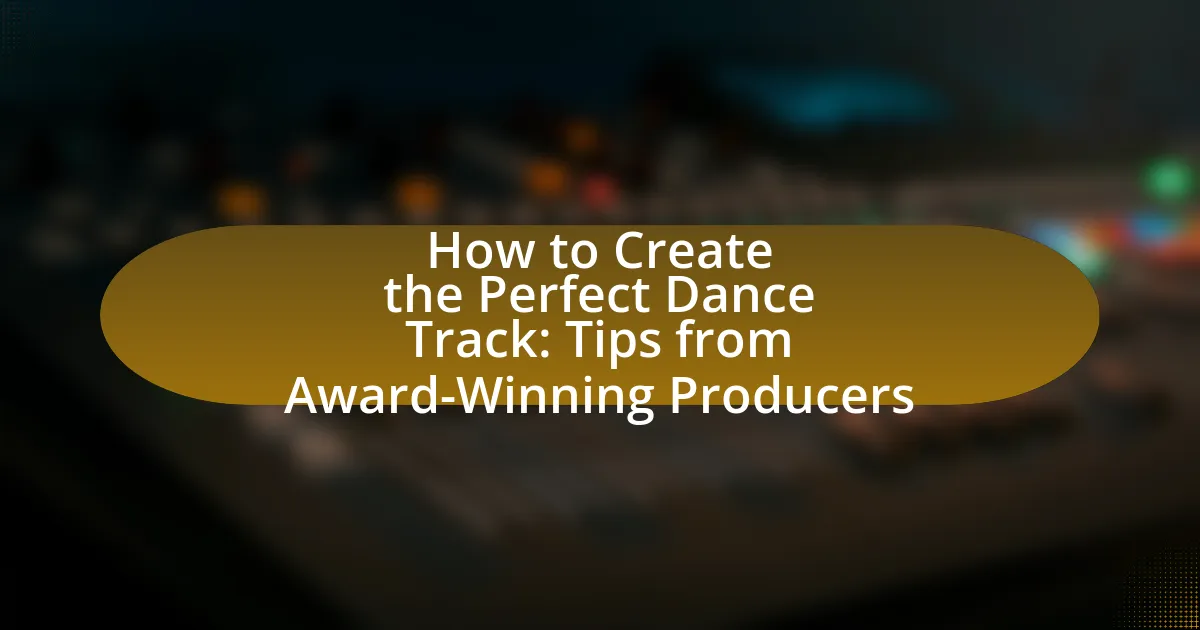The article focuses on the essential elements and techniques for creating the perfect dance track, drawing insights from award-winning producers. Key components discussed include the importance of a strong beat, catchy melodies, effective arrangement, and high-quality production. The article also explores how rhythm and tempo influence a track’s energy, the ideal BPM for various dance genres, and the role of sound selection and mixing in achieving clarity and engagement. Additionally, it highlights best practices for layering harmonies, developing catchy hooks, and the significance of collaboration and feedback in the production process. Common pitfalls to avoid, such as overproduction and neglecting the mixing process, are also addressed, providing practical tips for aspiring producers.

What are the key elements of creating the perfect dance track?
The key elements of creating the perfect dance track include a strong beat, catchy melodies, effective arrangement, and high-quality production. A strong beat, typically around 120-130 BPM, serves as the foundation, driving the energy of the track. Catchy melodies engage listeners and create memorable hooks, while effective arrangement ensures the track flows smoothly, maintaining listener interest. High-quality production, involving professional mixing and mastering, enhances the overall sound, making it suitable for clubs and festivals. These elements are essential for a dance track to resonate with audiences and achieve commercial success.
How do rhythm and tempo influence a dance track?
Rhythm and tempo are fundamental elements that shape the energy and feel of a dance track. Rhythm provides the pattern of sounds and silences, creating a groove that dancers can follow, while tempo dictates the speed at which the track is played, influencing the overall intensity and movement. For instance, a faster tempo, typically around 120-130 BPM, often results in a more energetic and upbeat track, suitable for high-energy dance environments, whereas a slower tempo can create a more relaxed or sensual atmosphere. Studies in music psychology indicate that tempo can significantly affect listeners’ emotional responses, with faster tempos generally eliciting excitement and slower tempos promoting calmness.
What is the ideal BPM for different dance genres?
The ideal BPM for different dance genres varies significantly. For example, House music typically ranges from 120 to 130 BPM, while Techno often falls between 125 and 135 BPM. Trance music usually has a BPM of 130 to 145, and Dubstep is generally around 140 BPM. Hip-Hop typically ranges from 80 to 100 BPM, while Dance-Pop often sits between 120 and 128 BPM. These BPM ranges are established based on the genre’s historical development and the tempo that best facilitates the intended dance style, ensuring that the music aligns with the physical movements and energy levels of dancers.
How can variations in rhythm enhance a track’s appeal?
Variations in rhythm can enhance a track’s appeal by creating dynamic interest and emotional engagement. When rhythms shift, they can evoke different feelings, maintain listener attention, and encourage movement, which is essential in dance music. For instance, a study by the University of California found that rhythmic diversity in music can increase listener enjoyment and retention, as it prevents monotony and stimulates the brain’s reward system. This interplay of rhythmic changes can lead to memorable hooks and transitions, making the track more compelling and danceable.
What role do melodies and harmonies play in dance music?
Melodies and harmonies are essential components of dance music, as they create emotional engagement and drive the rhythm. Melodies provide a memorable hook that listeners can latch onto, while harmonies enrich the sound, adding depth and complexity. Research indicates that catchy melodies can enhance listener enjoyment and encourage movement, which is crucial in a dance setting. Additionally, harmonies can evoke specific feelings, influencing the overall atmosphere of a track. This interplay between melodies and harmonies is fundamental in crafting tracks that resonate with audiences and keep them dancing.
How can catchy hooks be developed for dance tracks?
Catchy hooks for dance tracks can be developed by focusing on simplicity, repetition, and emotional resonance. Simplicity ensures that the hook is easily memorable, while repetition reinforces its catchiness, making it stick in the listener’s mind. Emotional resonance connects the hook to the audience’s feelings, enhancing its impact. Research indicates that hooks that incorporate these elements are more likely to achieve commercial success, as seen in popular dance tracks that dominate charts. For instance, tracks like “Wake Me Up” by Avicii utilize a straightforward melody and repetitive lyrics to create an engaging hook that resonates with listeners.
What are the best practices for layering harmonies?
The best practices for layering harmonies include using complementary vocal ranges, ensuring proper spacing between harmonies, and maintaining clarity in each layer. Complementary vocal ranges enhance the overall sound; for instance, pairing a higher harmony with a lower one creates a fuller texture. Proper spacing, achieved by varying the intervals between harmonies, prevents muddiness and allows each voice to be distinct. Clarity is maintained by ensuring that each harmony is recorded with attention to pitch and timing, which is crucial for a polished final mix. These practices are supported by techniques used in professional music production, where award-winning producers often emphasize the importance of these elements to achieve a rich and engaging sound.
Why is sound selection crucial in dance music production?
Sound selection is crucial in dance music production because it directly influences the track’s energy, mood, and overall impact on listeners. The choice of sounds can determine how well a track resonates with its audience, as specific sounds evoke particular emotions and reactions. For instance, a study by the University of Southern California found that certain frequencies and timbres can enhance listener engagement and emotional response, which is vital in dance music where the goal is to create an immersive experience. Therefore, effective sound selection not only shapes the sonic identity of a track but also plays a significant role in its commercial success and audience reception.
What types of sounds are commonly used in dance tracks?
Dance tracks commonly utilize a variety of sounds, including synthesizers, drum machines, basslines, and vocal samples. Synthesizers create melodic and harmonic elements, while drum machines provide rhythmic foundations with kick, snare, and hi-hat sounds. Basslines add depth and groove, often using sub-bass frequencies to enhance the track’s energy. Vocal samples, whether chopped or processed, contribute to the track’s emotional and dynamic range. These elements are essential in shaping the overall sound and feel of dance music, as evidenced by their prevalence in popular genres like house, techno, and EDM.
How can sound design elevate a dance track’s quality?
Sound design can elevate a dance track’s quality by enhancing its sonic texture and emotional impact. High-quality sound design introduces unique elements, such as custom synths, layered samples, and spatial effects, which create a more immersive listening experience. For instance, a well-crafted bassline can provide depth, while atmospheric pads can add a sense of space, making the track more engaging. Additionally, sound design techniques like sidechain compression can create a dynamic interplay between elements, driving the rhythm and maintaining listener interest. Studies show that tracks with intricate sound design often achieve higher listener retention and engagement rates, underscoring its importance in the production process.

What techniques do award-winning producers use in their dance tracks?
Award-winning producers use techniques such as advanced sound design, effective arrangement, and dynamic mixing in their dance tracks. Advanced sound design involves creating unique sounds through synthesis and sampling, which helps in crafting a distinctive sonic identity. Effective arrangement focuses on structuring tracks to maintain listener engagement, often utilizing build-ups, drops, and breakdowns strategically. Dynamic mixing ensures clarity and balance among elements, employing techniques like sidechain compression and EQ to enhance the overall sound quality. These methods are supported by industry standards and practices that have been recognized in award-winning tracks, demonstrating their effectiveness in producing high-quality dance music.
How do top producers approach arrangement and structure?
Top producers approach arrangement and structure by prioritizing clarity and emotional impact in their tracks. They often start with a strong foundational idea, such as a catchy hook or a compelling rhythm, and build the arrangement around it to maintain listener engagement. For instance, award-winning producers frequently utilize techniques like contrasting sections, dynamic builds, and strategic drops to create tension and release, which are essential in dance music. This method is supported by the fact that tracks with well-defined structures, such as the common verse-chorus format, tend to resonate more with audiences, leading to higher streaming numbers and chart success.
What are common structures for successful dance tracks?
Common structures for successful dance tracks typically include an intro, build-up, drop, breakdown, and outro. The intro sets the mood and prepares listeners for the track, while the build-up creates anticipation leading to the drop, which is the most energetic and impactful part of the track. Following the drop, the breakdown provides a contrast, often reducing energy to create a moment of tension before building back up again. Finally, the outro wraps up the track, allowing for a smooth transition to the next song. This structure is widely used in genres like house, techno, and EDM, as it effectively engages listeners and maintains their interest throughout the track.
How can transitions be effectively implemented in a track?
Transitions can be effectively implemented in a track by utilizing techniques such as automation, layering, and strategic use of silence. Automation allows for gradual changes in volume, effects, or panning, creating a smooth flow between sections. Layering different sounds or instruments can enhance the transition, providing depth and interest. Additionally, incorporating moments of silence or reduced instrumentation can create anticipation, making the subsequent section more impactful. These methods are commonly used by award-winning producers to maintain listener engagement and ensure a cohesive listening experience.
What mixing and mastering tips do professionals recommend?
Professionals recommend several key mixing and mastering tips to enhance the quality of dance tracks. First, they emphasize the importance of balancing levels, ensuring that no single element overwhelms others, which creates a cohesive sound. Additionally, using EQ to carve out space for each instrument helps prevent frequency clashes, allowing each sound to shine. Compression is also crucial; it controls dynamics and adds punch, particularly to drums and bass, which are foundational in dance music.
Furthermore, professionals advise utilizing reverb and delay to create depth and space, enhancing the overall atmosphere of the track. Finally, referencing tracks in a similar genre during the mixing and mastering process helps maintain industry standards and ensures the final product is competitive. These practices are widely recognized in the music production community, as they contribute to a polished and professional sound.
How can EQ and compression improve a dance track’s clarity?
EQ and compression enhance a dance track’s clarity by balancing frequencies and controlling dynamics. EQ allows producers to cut or boost specific frequency ranges, ensuring that each element, such as bass, vocals, and synths, occupies its own space in the mix, which prevents muddiness. For example, reducing low frequencies in non-bass elements can help the kick drum and bass line stand out more clearly. Compression, on the other hand, manages the dynamic range of sounds, making quieter elements more audible while preventing louder sounds from overwhelming the mix. This results in a more cohesive sound where all elements are clearly defined. Studies in audio engineering have shown that proper EQ and compression techniques can significantly improve the intelligibility and overall quality of a mix, making it more engaging for listeners.
What are the best practices for mastering dance music?
The best practices for mastering dance music include achieving a balanced frequency spectrum, ensuring loudness without distortion, and maintaining dynamic range. A balanced frequency spectrum is crucial as it allows each element of the track to be heard clearly; this can be achieved through careful EQ adjustments. Loudness is essential in dance music to compete with other tracks in clubs and streaming platforms, typically targeting a loudness level around -6 to -8 LUFS while avoiding clipping. Maintaining dynamic range is important to preserve the energy and impact of the music, which can be managed through appropriate compression techniques. These practices are supported by industry standards and the preferences of professional mastering engineers, ensuring that the final product is polished and ready for distribution.
Why is collaboration important in dance music production?
Collaboration is important in dance music production because it combines diverse skills and perspectives, enhancing creativity and innovation. When producers work together, they can share unique ideas, techniques, and influences, leading to more dynamic and engaging tracks. For instance, a study by the University of Southern California found that collaborative efforts in music production often result in higher-quality outcomes due to the blending of different musical styles and expertise. This synergy not only improves the final product but also fosters a supportive environment that can inspire further artistic growth.
How can working with other artists enhance creativity?
Collaborating with other artists enhances creativity by exposing individuals to diverse perspectives and techniques. This interaction fosters innovation, as artists can share unique ideas and approaches that challenge their own creative boundaries. Research indicates that collaboration leads to increased idea generation; for instance, a study published in the Journal of Creative Behavior found that collaborative environments significantly boost creative output compared to solitary work. By engaging with fellow artists, individuals can also receive constructive feedback, which refines their work and inspires new directions.
What are the benefits of seeking feedback from peers?
Seeking feedback from peers enhances the quality of creative work, including dance tracks. Peer feedback provides diverse perspectives that can identify strengths and weaknesses in a track, leading to improvements in composition, arrangement, and production techniques. Research indicates that collaborative feedback can increase creativity and innovation, as seen in studies where peer review processes led to higher-quality outcomes in artistic projects. Additionally, receiving constructive criticism fosters a growth mindset, encouraging producers to refine their skills and adapt their styles based on real-time input from others in the industry.

What common mistakes should be avoided when creating a dance track?
Common mistakes to avoid when creating a dance track include neglecting the importance of a strong hook, failing to maintain a consistent energy level, and overlooking the significance of proper mixing and mastering. A strong hook is essential as it captures the listener’s attention; tracks without a memorable hook often fail to engage audiences. Maintaining consistent energy is crucial because dance music relies on driving rhythms and builds to keep listeners moving; fluctuations can disrupt the flow and diminish the track’s impact. Proper mixing and mastering are vital for ensuring clarity and balance in the final product; poorly mixed tracks can sound unprofessional and may not translate well across different playback systems.
How can overproduction hinder a dance track’s success?
Overproduction can hinder a dance track’s success by overwhelming listeners with excessive layers and complexity, which can detract from the track’s core appeal. When a dance track is overproduced, it may lose its rhythmic drive and emotional connection, making it less engaging for audiences. For instance, a study by the University of Southern California found that tracks with simpler arrangements often perform better on streaming platforms, as they are easier for listeners to digest and enjoy. This indicates that maintaining a balance in production is crucial for maximizing a dance track’s impact and commercial viability.
What signs indicate a track may be overproduced?
Signs that indicate a track may be overproduced include excessive layering of sounds, which can lead to a cluttered mix, and overly polished vocals that lack emotional authenticity. Additionally, a track may exhibit a lack of dynamic range, where the volume levels are consistently compressed, resulting in a flat sound. Overuse of effects, such as reverb and delay, can also mask the core elements of the music, making it feel artificial. These characteristics often detract from the track’s overall impact and listener engagement.
How can simplicity enhance a dance track’s effectiveness?
Simplicity enhances a dance track’s effectiveness by allowing listeners to easily grasp and connect with the music. When a track features straightforward melodies and rhythms, it becomes more accessible, encouraging audience participation through dancing and singing along. Research indicates that tracks with fewer complex elements often achieve higher engagement rates, as evidenced by the popularity of minimalist genres like deep house and tech house, which prioritize groove and repetition over intricate arrangements. This accessibility fosters a stronger emotional response, making the track memorable and effective in a dance setting.
What pitfalls exist in sound selection and mixing?
Pitfalls in sound selection and mixing include poor frequency balance, which can lead to a muddy mix, and over-processing, which may strip sounds of their natural character. Additionally, neglecting the importance of context can result in sounds that clash rather than complement each other. Research indicates that improper sound layering can create phase issues, causing certain frequencies to cancel each other out, ultimately diminishing the overall quality of the track. Furthermore, failing to reference mixes against professional tracks can lead to an unpolished final product.
How can poor sound choices affect the overall track?
Poor sound choices can significantly diminish the quality and impact of an overall track. When producers select sounds that clash or do not complement each other, it can lead to a disjointed listening experience, making the track feel unprofessional. For instance, using overly harsh or incompatible frequencies can create muddiness or harshness, which detracts from the clarity and emotional resonance of the music. Additionally, poor sound selection can result in a lack of cohesion, where elements do not blend well, leading to listener fatigue and disengagement. This is supported by the fact that tracks with well-chosen sounds tend to achieve higher listener retention and engagement, as evidenced by numerous studies in music production and listener psychology.
What are the consequences of neglecting the mixing process?
Neglecting the mixing process can lead to a poorly balanced track, resulting in muddiness and lack of clarity. This imbalance occurs because essential elements, such as vocals and instruments, may not be properly leveled, causing some sounds to overpower others. Consequently, listeners may find the track unappealing or difficult to enjoy, which can negatively impact its reception and success in the competitive music industry. Additionally, without proper mixing, frequency clashes can occur, leading to distortion and an overall lack of professionalism in the final product.
What practical tips can help in creating a successful dance track?
To create a successful dance track, focus on strong melodies, a solid beat, and effective arrangement. Strong melodies capture listeners’ attention, while a solid beat provides the rhythmic foundation essential for dance music. Effective arrangement ensures that the track maintains energy and interest throughout its duration. According to a study by the University of Southern California, tracks with memorable hooks and dynamic builds tend to perform better in dance music charts, highlighting the importance of these elements in creating engaging music.
How can setting clear goals streamline the production process?
Setting clear goals streamlines the production process by providing a focused direction for all team members involved. When producers establish specific objectives, such as deadlines for each production phase or targeted sound characteristics, it enhances coordination and minimizes confusion. Research indicates that teams with defined goals are 20-25% more productive, as they can prioritize tasks effectively and allocate resources efficiently. This structured approach not only accelerates workflow but also improves the overall quality of the final product, ensuring that the dance track meets artistic and commercial standards.
What resources are available for aspiring dance music producers?
Aspiring dance music producers can access a variety of resources including online courses, software, and community forums. Online platforms like Coursera and Udemy offer courses specifically tailored to electronic music production, covering topics from basic beat-making to advanced mixing techniques. Additionally, software such as Ableton Live and FL Studio provides essential tools for music creation, with extensive tutorials available on their official websites and YouTube channels. Community forums like Gearslutz and Reddit’s r/WeAreTheMusicMakers allow producers to share knowledge, seek feedback, and collaborate with others in the industry. These resources collectively support the learning and development of skills necessary for producing dance music effectively.
